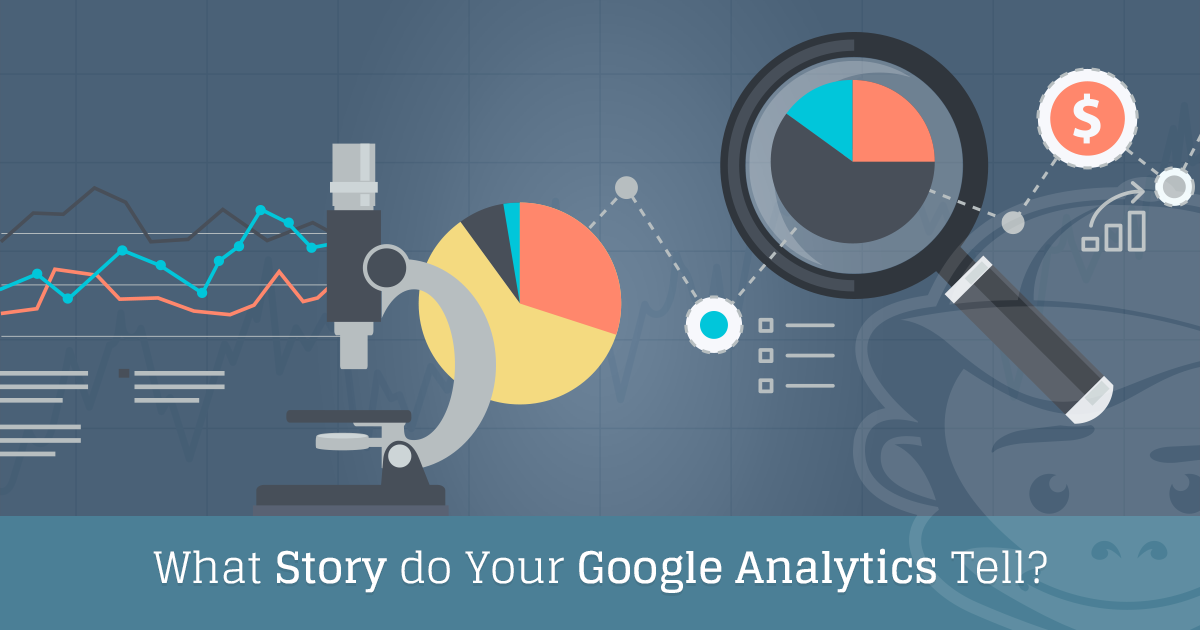Is your Google Analytics Account telling you the whole story? If you’re not creating one or more custom Google Analytics reports, then you’re only scratching the surface.
Or worse yet, you could completely misunderstand the results, leading you to make a decision on a flawed analysis.
But the great news is that it’s not difficult to set up a custom Google Analytics report.
Let’s get to it!
What Are Custom Reports?
 The default, out-of-the-box, reports allow you to, at a glance, see the information that’s most relevant to people across the board.
The default, out-of-the-box, reports allow you to, at a glance, see the information that’s most relevant to people across the board.
When you first set up your Google Analytics (GA) account, you instantly see data like:
- Traffic volume
- Sources
- Bounce rate.
For people who are just getting started this information seems like a goldmine. But it’s really only the tip of the iceberg.
When you need to make business decisions that will impact your bottom line, you need to go much deeper. You need to see the data on what’s important to you.
Through this insight, you can further streamline the user experience, optimize the buyer’s journey and maximize your return on investment.
Setting Up a Custom Google Analytics Report
Setting up a custom report is easy. Deciding what you want to track can be more complex.
To set up GA custom reports, simply log into your GA account. Open reports. Click on customization. The custom reports. Then new custom report.
Give it a name. You can always change this later. Add a report tab.
Here you’ll select a report type. These names may seem foreign to you so we’ll walk through each one to help you choose the one or more that’s right for you.
Report Types
Explorer — This is your standard GA report. It’s your more dynamic data display option with graphs and tables to help you visualize data quickly.
Flat table — What the flat table sacrifices in terms of visual appeal, it makes up for in functionality. If you need to be able to sort the data in many different ways like an Excel spreadsheet, this is what you’re looking for.
Map overlay — The map overlay adds another visual element that is particularly helpful for national and international businesses. With this report, you get a visual representation of what’s happening with your website traffic geographically.
Funnel — And perhaps the most important and unique to you, we have the funnel. Whether you called it a sales funnel or a buyer’s journey, you have a clear path for people to take through your site.
With the funnel report, you see how well you’re guiding people along that designed path. In doing so, you can identify the leaks in your funnel and patch them up.
Dimensions & Metrics

These will be different depending on which report type you chose. But by understanding what these are you’ll be able to choose the one that provides you with most relevant data.
Dimensions describe a characteristic of the traffic. What geographic location did it come from? What browser is being used? Did the traffic use a desktop/laptop, tablet or mobile phone?
Depending on the report, you’ll be able to see the number of visitors in each dimension as well as how visitors in that dimension interacted with your site in terms of bounce rate, load speed, sessions, conversion rate, etc. Is your website responsive to that group?
These are all metrics. They are things you want to measure — or at least be aware of and track. If you have a high bounce rate on mobile, you’ll want to find out why fast.
If a higher percentage of traffic from X location is converting, you’ll want to figure out what may be different about that location. Or you might choose to re-double your efforts there.
Add Filter
After you’ve set up a dimension and metric, you may decide whether one dimension is especially important or unimportant. You can set up the custom Google Analytics report to focus on a certain type of browser, for example.
If you have multiple views on your account, you can choose which views this custom report will appear on.
Deciding What to Include in Your Report

Once you explore the breadth of data that you can quickly aggregate and make easily usable in decision-making, you may be rethinking what you want to capture and measure.
Consider what questions you want answered to design your custom Google Analytics report.
These might include:
Is anyone visiting page X?
From what page are people most likely to exit the site?
Does the browser or device they’re using factor into this?
The important thing to remember here is that analytics should make things easier not harder because you have more solid information on which to make decisions.
Sit down with your company goals. Consider your KPIs, then browse various reporting options to see what information helps you answer important questions.
If you’re new to analytics, then start small. Don’t allow yourself to become so overwhelmed by data that you can’t see an individual tree because it just looks like a forest.
Each tree is a customer. And what you do as a result of this data can make a huge difference.
Google Analytics Solution Gallery
This is an official Google site that allows people who’ve been using Google Analytics for a while to share the custom reports that they use. Much like an app store, people rate and review the reports.
These custom reports are completely free and are a great way to implement custom reporting.
Simply browse through the reports and test them out to see which ones most closely align with your goals. Once you have this template, you can further customize it to meet your unique needs.
This community approach is a great way to make sure you’re not recreating the wheel as you familiarize yourself with the awesome power of the custom report.
Analyze and Thrive
Businesses today thrive on analytics. With the custom Google Analytics report, you can have a better understanding of how visitors interact with your site.
You can divide users into dimensions and segments to improve the user experience for each group. You can better understand the who, where, how, and what of your visitors.
To find out how we can help you get the most out of your analytics, contact us today.>






